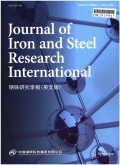- 钛学术文献服务平台 \
- 学术期刊 \
- 工业技术期刊 \
- 冶金工业期刊 \
- 钢铁研究学报(英文版)期刊 \
Printability and physical properties of iron slag powder composites using material extrusion-based 3D printing
Printability and physical properties of iron slag powder composites using material extrusion-based 3D printing
基本信息来源于合作网站,原文需代理用户跳转至来源网站获取
摘要:
There have been many studies on three-dimensional (3D) printing using metal compounds. However, 3D printing using a metal compound has disadvantages in that it increases the cost for supplying metal materials. A method of using slag which is a recyclable material has been proposed to reduce costs. With the growing demand for additive manufacturing using by-products, slag has gained attention as a diverse recycling material for 3D printing technologies. A new fabrication approach was analyzed for producing porous bodies via additive manufacturing for blending slag and reinforced metals. However, because of its low quality due to low strength, low durability, and structural defeats, the amount of slag generated is high, and its usability remains uncertain. Also, slag is an excellent material with a huge potential for producing structures with high mechanical properties, and limited research in the area of slag recycling has been conducted due to diffculties in sintering the iron by-products. To develop a recycling approach that utilizes slag in 3D printing powders, a study to increase the industrial usability by mixing slag and ceramic beads was described. A method was presented to compare the physical properties of 3D printed slag parts with the physical properties of those generated by blending iron slag, alumina, and zirconia. In order to find the mixing ratio with the optimum physical properties, the average particle size, bending stress, and maximum compressive stress were tested. The combination ratio to obtain the highest strength was when iron slag powder was 40% and alumina was 60%. In addition, the specimens by composition to which the stress test was applied were cut to analyze the tissue under a microscope. It is thought that cracking in the sintered structure decreases and density increases by mixing alumina and zirconium, contributing to increased strength. When a ceramic bead composed of alumina and zirconium is mixed with slag to form a composite material, a metal compound having a level of physical properties that can be used as a material for 3D printing can be produced. Furthermore, a novel concept of producing lightweight structural materials via additive manufac-turing, which entails a fabrication process whereby high-strength metals are stacked inside hollow base steels, was proposed.

内容分析
关键词云
关键词热度
相关文献总数
(/次)
(/年)
文献信息
| 篇名 | Printability and physical properties of iron slag powder composites using material extrusion-based 3D printing | ||
| 来源期刊 | 钢铁研究学报(英文版) | 学科 | |
| 关键词 | |||
| 年,卷(期) | 2021,(1) | 所属期刊栏目 | ORIGINAL PAPERS |
| 研究方向 | 页码范围 | 111-121 | |
| 页数 | 11页 | 分类号 | |
| 字数 | 语种 | 英文 | |
| DOI | |||
五维指标
引文网络
引文网络
二级参考文献 (0)
共引文献 (0)
参考文献 (0)
节点文献
引证文献 (0)
同被引文献 (0)
二级引证文献 (0)
2021(0)
- 参考文献(0)
- 二级参考文献(0)
- 引证文献(0)
- 二级引证文献(0)
引文网络交叉学科
相关学者/机构
期刊影响力
钢铁研究学报(英文版)
主办单位:
钢铁研究总院
出版周期:
月刊
ISSN:
1006-706X
CN:
11-3678/TF
开本:
大16开
出版地:
北京市海淀区学院南路76号
邮发代号:
创刊时间:
1994
语种:
eng
出版文献量(篇)
2637
总下载数(次)
0
总被引数(次)
11488
期刊文献
相关文献
推荐文献
- 期刊分类
- 期刊(年)
- 期刊(期)
- 期刊推荐
一般工业技术
交通运输
军事科技
冶金工业
动力工程
化学工业
原子能技术
大学学报
建筑科学
无线电电子学与电信技术
机械与仪表工业
水利工程
环境科学与安全科学
电工技术
石油与天然气工业
矿业工程
自动化技术与计算机技术
航空航天
轻工业与手工业
金属学与金属工艺
钢铁研究学报(英文版)2022
钢铁研究学报(英文版)2021
钢铁研究学报(英文版)2020
钢铁研究学报(英文版)2019
钢铁研究学报(英文版)2018
钢铁研究学报(英文版)2017
钢铁研究学报(英文版)2016
钢铁研究学报(英文版)2015
钢铁研究学报(英文版)2014
钢铁研究学报(英文版)2013
钢铁研究学报(英文版)2012
钢铁研究学报(英文版)2011
钢铁研究学报(英文版)2010
钢铁研究学报(英文版)2009
钢铁研究学报(英文版)2008
钢铁研究学报(英文版)2007
钢铁研究学报(英文版)2006
钢铁研究学报(英文版)2005
钢铁研究学报(英文版)2004
钢铁研究学报(英文版)2003
钢铁研究学报(英文版)2002
钢铁研究学报(英文版)2001
钢铁研究学报(英文版)2000
钢铁研究学报(英文版)1999
钢铁研究学报(英文版)2021年第9期
钢铁研究学报(英文版)2021年第8期
钢铁研究学报(英文版)2021年第7期
钢铁研究学报(英文版)2021年第6期
钢铁研究学报(英文版)2021年第5期
钢铁研究学报(英文版)2021年第4期
钢铁研究学报(英文版)2021年第3期
钢铁研究学报(英文版)2021年第2期
钢铁研究学报(英文版)2021年第12期
钢铁研究学报(英文版)2021年第1期

 免费查重
免费查重










